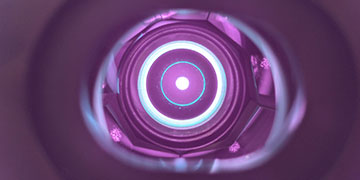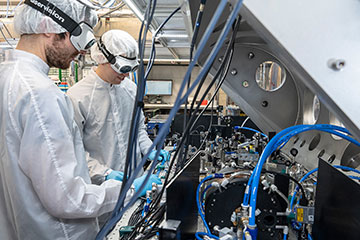
An inside look at the thin-disk laser. Pictured is the round amplifier disk that the laser beam passes through several times. [Image: Moritz Seidel / ETH Zurich]
Scientists in Switzerland have reportedly used a thin-disk laser to set a new record for the highest average power from a mode-locked oscillator, at 550 Watts (Optica, doi: 10.1364/OPTICA.529185). They say that this result, combined with the device's very short pulse length, opens up new possibilities for applications such as attosecond science or the extension of frequency combs to short wavelengths.
Extremely thin disk
Lasers with high average powers are used in a wide range of tasks within research, such as observing chemical reactions and other processes on the shortest timescales, and also in industry, like for machining metal and glass on very small spatial scales). However, the current approach for achieving these powers―chirped pulse amplification―is fairly cumbersome. It involves taking exceptionally short pulses from a mode-locked oscillator, stretching those pulses with diffraction gratings, safely amplifying them, and then recompressing them with another grating.
In the latest research, Ursula Keller and colleagues at ETH Zurich instead generate high average powers within the oscillator itself. They do this using a lasing medium in the form of an extremely thin disk-shaped crystal containing atoms of ytterbium. The disk removes heat very efficiently along its axis, allowing it, in principle, to handle more intense laser beams without its optical properties becoming impaired. But because the lasing medium is much shorter than that of a typical solid-state laser, the disk must be exposed to the beam multiple times―an onerous requirement that the group says has led to some “spectacular incidents” during its 25-year development of the technology.
Lead author Moritz Seidel explains that the multiple exposures must preserve the beam's single mode, which is needed to carry out the mode-locking that yields exceptionally short pulses. And that in turn means that when the beam returns to the disk, it must always strike it in exactly the same spot―more specifically, the beam must coincide with no less than 80% of the initial spot generated by the pump beam. He and his colleagues were able to achieve this by using a fairly elaborate arrangement of mirrors to create the laser cavity.

Lukas Lang (left), Moritz Seidl and colleagues at ETH Zurich have devised an optical layout that allows a very thin disk oscillator to be exposed to laser light multiple times, boosting its average power to record levels. [Image: Heidi Hofstetter / ETH Zurich]
House of mirrors
Rather than passing through the gain medium twice on each round trip, as it would in a normal laser, the light generated by the stimulated emission instead goes back and forth through the thin disk 12 times. The light passes through an antireflective coating on the disk's front side, bounces off a reflecting coating on the crystal's rear surface, then reflects off two of a dozen mirrors in an array placed opposite the disk in such a way as to return to exactly the same spot on the disk. Then it repeats the exercise with another pair of mirrors in the array, and so on, until it has bounced off all 12 mirrors. The light's route is determined such that on every round trip, it arrives once at each of the cavity's end mirrors—a coupler to direct some of the beam to the outside, and a device known as a semiconductor saturable absorber mirror (SESAM).
This mirror, made from a number of semiconductor quantum wells, converts the laser's otherwise continuous-wave output into pulses, thanks to the fact that it reflects higher-intensity light back into the cavity more efficiently than it does lower-intensity light (pulses, being shorter, have a higher intensity). To cope with the more stringent demands of the latest work, the researchers implanted ions into the quantum well structure and bonded this structure to a layer of sapphire, improving thermal management and also ensuring that the mirror remains flat.
Keller and colleagues carried out the experiment using a disk 18 mm across but just 100 µm thick, pumping it with light at 940 nm. They operated the oscillator in a vacuum chamber, but they varied the air pressure within the chamber in order to retain mode-locking as they ramped the laser's power up, going from atmospheric pressure at 85 W of average power down to just 33 millbars at 550 W.
Pulses packed with power
The researchers were able to achieve the 550 W average power with pulses about 850 femtoseconds long repeated 5.5 million times per second, implying that each pulse packed 100 microJoules of energy and had a peak power of 103 MW. They say that, to the best of their knowledge, this output represents the highest average power and highest pulse energy of any mode-locked oscillator. This performance, they claim, “shows the competitiveness of oscillators when compared with amplifier systems,” and they explain that an oscillator on its own produces less shot noise and so may enable more sensitive pump–probe measurements.
Possible applications of the work, they say, include generating high-harmonic laser light at high repetition rates, which would come in very handy for attosecond science. The strong, rapid-fire pulses could also be used for frequency comb spectroscopy at extreme ultraviolet wavelengths, which, according to Keller, might in future be exploited to make exceptionally accurate nuclear clocks.
The researchers add that their disk laser could achieve even higher powers by using a larger SESAM, to limit the amount of energy that the special mirror is exposed to per unit area. But they say that carrying out the necessary bonding, as well as adapting the optical cavity to better compensate for the resulting thermal distortions, would be “non-trivial.”
